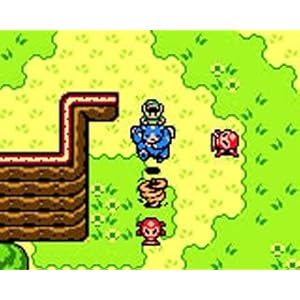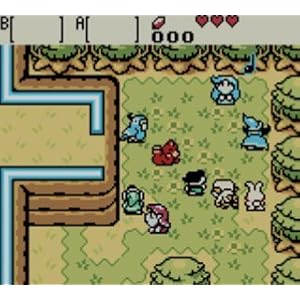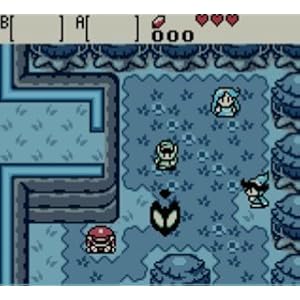Search
[{{{type}}}] {{{reason}}}
{{/data.error.root_cause}}{{{_source.title}}} {{#_source.showPrice}} {{{_source.displayPrice}}} {{/_source.showPrice}}
{{#_source.showLink}} {{/_source.showLink}} {{#_source.showDate}}{{{_source.displayDate}}}
{{/_source.showDate}}{{{_source.description}}}
{{#_source.additionalInfo}}{{#_source.additionalFields}} {{#title}} {{{label}}}: {{{title}}} {{/title}} {{/_source.additionalFields}}
{{/_source.additionalInfo}}- Details
- Category: GBC
- By Jason Gress
- Hits: 11601
The Legend of Zelda: Oracle of Ages (GBC)

Developed and Published By: Nintendo
Available On: Game Boy Color
Genre: Action Adventure
Number of Players: 1
ESRB Rating: E
Retail Price: $13 (Amazon affiliate link)
I played through this as a linked game; some of my character\'s items were transferred from Oracle of Seasons, so my gameplay was slightly different than a player choosing \'New Game\'.
Every once in a while, I get the idea that I need to take a break from modern gaming experiences and catch up on some of the classics that I missed. When I realized that I had never played the two Game Boy Color Zelda games, I made sure to correct that by picking them up used at a local used game shop. I\'m glad that I did - these are very solid adventures.
In 2001, Nintendo and Capcom decided to team up to make a pair of Zelda games for the Game Boy Color. Oracle of Ages and Oracle of Seasons are both distinctly separate adventures, that when linked together, show that there is a common enemy behind the attacks on each land. Oracle of Ages takes place in Labyrnna, while Oracle of Seasons takes place in Holodrum.
One day, Link wakes up and finds himself in a strange forest. He hears a voice crying for help, and finds Impa, Princess Zelda\'s nurse from Hyrule, who is looking for a singer named Nayru. You help her find Nayru, who is the Oracle of Ages, and can control time. Impa was being possessed by Veran, the Sorceress of Shadows. Upon finding Nayru, she leaves Impa\'s body and takes over the Oracle of Ages. She then leaves through a time portal that she opens, going back three hundred years to bring darkness and despair to the world.
Pros: Classic Zelda game play; very challenging puzzles; unique items and weapons; neat game link system with Oracle of Seasons; very long and satisfying adventure
Cons: Very challenging puzzles; constrained by Game Boy Color hardware
Moral Warnings: Fantasy Violence; magic used by the player and enemies; the adversary posesses friendly characters and turns them against you
In its essence, Oracle of Ages is similar to other classic 2D Zelda games, like Link\'s Awakening, A Link to the Past, and even the original Legend of Zelda. In this adventure, you play as Link, and you wield a sword, sheild, and other various weapons and items that you pick up in your adventure, including a boomerang, bombs, a switch hook, a seed shooter, and many others. It draws many elements from the classic original Zelda, while borrowing and inventing newer elements to go with it.
This game is played with a 2D, top down perspective. You see your enemies move towards you, and you slash them with your sword or other weapon to eliminate them. There are usually between one and six or so enemies on the screen at a time. Each screen is independent; there is little to no scrolling in a room, with a few rooms in dungeons being an exception. When you reach the edge of the screen on your GBC, the whole screen moves and you begin on the next screen on the opposite side. It\'s very much like the classic Legend of Zelda that way.
The protector of the land, the Maku Tree, who is female in this game (he\'s male in Oracle of Seasons), wants to help you save the land and rescue Nayru. As a result, she gives you hints on what to do next, and where to go next. She leads you to find each of the Essences of Time, which leads you to eight complex dungeons, with a new powerful item and a boss inside. It also rewards you with a heart container, which increases your maximum health.
Higher is better
(10/10 is perfect)
Game Score - 90%
Game Play 18/20
Graphics 9/10
Sound/Music 9/10
Stability/Polish 5/5
Controls/Interface 4/5
Violence 8/10
Language 10/10
Sexual Content/Nudity 10/10
Occult/Supernatural 5/10
Cultural/Moral/Ethical 10/10
Early on in your quest, you gain the Harp of Ages. This item allows you to travel through time, between the present time, and 400 years in the past. This is the main change mechanic in Oracle of Ages - as you travel through time, things change. Sometimes a path is blocked in the present that is open in the past, and vice versa. You can also place vine seeds in certain places in the past to allow you to access those platforms in the present. There are other things, including quests and even a dungeon that requires time travel. It\'s kind of like the light and dark world of A Link to the Past, except there is nothing dark about the past, though it does use a darker color pallete that makes it appear older. All in all, it\'s a proven game mechanic that works well here.
In Zelda games, Link increases his power not by gaining levels or some direct character improvement mechanism, but by acquiring items. There are some unique items in this adventure never seen before in a Zelda game. The first is the Seed Satchel, and eventually, the Seed Shooter. You can find five kinds of seeds throughout your adventure, and they do different things either launched from the Seed Shooter or used from the Seed Satchel. Ember Seeds burn items, Gale Seeds transport you to any other seed tree you have visited, Pegasus Seeds help you run much faster, Scent Seeds help draw enemies to them, and Mystery Seeds are used to solve puzzles. Other unique items include the Strange Flute, the Mermaid Suit, and the very neat Cane of Somaria. I was pleasantly surprised by the many and unique items in not only Oracle of Ages, but Oracle of Seasons. In this game, the puzzles use them in many very creative ways.
Speaking of puzzles, this game, Oracle of Ages, really takes the cake. There are some diabolically hard puzzles in this game; perhaps some of the trickiest in the series. Some particularly memorable ones to me were the Mermaid\'s Cave, and Jabu-Jabu\'s Belly. Mermaid\'s cave requires going back and forth to the same cave in multiple time periods, and Jabu-Jabu\'s Belly requires some really fun and difficult puzzles involving raising and lowering the water level. All in all, I can\'t help but highly recommend this game for those who love complex puzzles in Zelda games.










